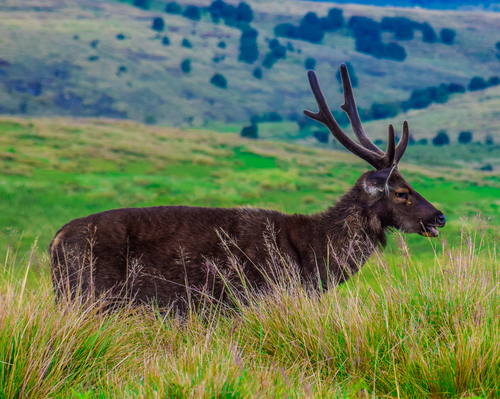The Deer of Sri Lanka: Graceful Inhabitants of the Wild-by Kalani-eLanka

Sri Lanka, known for its rich biodiversity and lush landscapes, is home to several species of deer. These graceful creatures are commonly found in the island’s national parks, forests, and grasslands. They play a vital role in the ecosystem and are a significant part of Sri Lanka’s wildlife heritage.
Types of Deer in Sri Lanka
There are several types of deer in Sri Lanka, each with unique characteristics:
-
Spotted Deer (Axis axis)
Also known as the Chital, the spotted deer is the most common species found in Sri Lanka. It is easily recognized by its reddish-brown coat covered with white spots. These deer are usually seen in large herds in dry zone national parks such as Yala, Wilpattu, and Minneriya. -
Sambar Deer (Rusa unicolor)
The sambar is the largest species of deer in Sri Lanka. It has a dark brown coat and impressive antlers in males. Sambar deer are usually found in montane forests, such as Horton Plains National Park, where they are often seen grazing early in the morning. -
Barking Deer (Muntiacus muntjak)
Also known as the Indian muntjac, this is a small and shy species of deer. It is named for its bark-like alarm call. Barking deer prefer dense forests and are more difficult to spot compared to other deer species.
Habitat and Distribution
Deer in Sri Lanka inhabit a wide range of environments—from dry lowland forests and grasslands to cool highland forests. National parks and wildlife reserves provide a safe haven for these animals, where they coexist with predators like leopards and jackals.
Behavior and Diet
Deer are herbivores and feed on grass, leaves, fruits, and bark. They are typically active during early morning and late afternoon. Spotted deer are social animals and form large groups, while sambar and barking deer tend to be more solitary or form small groups.
Role in the Ecosystem
Deer play a crucial role in maintaining the balance of the ecosystem. They are primary prey for predators such as the Sri Lankan leopard. Their grazing habits also help control plant growth and promote new vegetation.
Conservation and Protection
Although deer populations are relatively stable in protected areas, they face threats such as habitat loss, poaching, and human-wildlife conflict. Conservation efforts by the Department of Wildlife Conservation and various NGOs aim to protect these beautiful animals and their habitats.
Conclusion
Deer are among the most elegant and iconic animals in Sri Lanka’s wild. Their presence in the island’s forests and grasslands is a symbol of the country’s natural wealth. Protecting these animals ensures the health of the ecosystems they inhabit and preserves the beauty of Sri Lanka’s wilderness for future generations.






















